Farming sims are a dime a dozen these days, and that’s saying something because I’m writing this during Steam’s painfully optimistic “Spring Sale 2024” and I am sure some/many/most/all of those farming sims are on some kind of discount right now. Regardless of whether or not your character lives in a normal world, a supernatural world, or a sci-fi world, farming sims usually start you out as having inherited a run-down farm which you are asked to renovate and cultivate, involve a nearby town populated by a standard anime’s worth of basic characters (cranky old guy, smart scientist-type, kids, “hunks and babes”, the quirky shy guy/girl, etc.) with whom you form relationships and can even date and/or marry eventually, and that really annoying “stamina” mechanic which requires you to sleep every real-world 15 minutes lest you pass out and get forced to lay down. A few have thankfully gotten away from the “you must rest to save” mechanic but it seems like many devs consider this feature to be “endearing” and not at all “wasteful” and “really fucking obnoxious”. Man, I hate that mechanic.
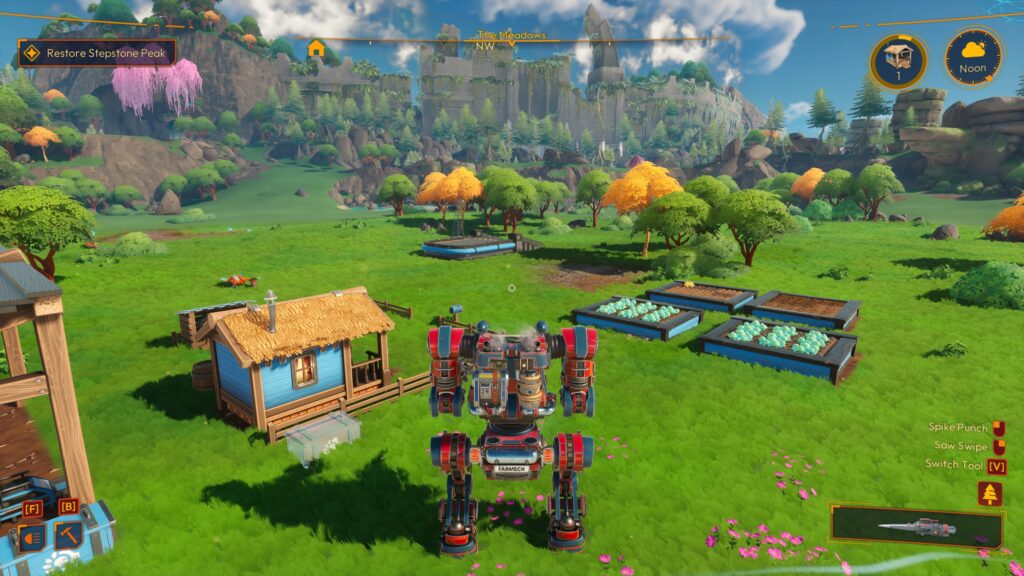
Lightyear Frontier is a farming sim, but isn’t like any of those. It’s one part farming sim, one part exploration, one part allegory for environmental stewardship, and one part relaxing “existancebox”.
Head Coreward, Young Person
Scene: The Earth is a mess. Humanity had tried to relocate to far-away planets that were like Earth through the “Lightyear Program” but abandoned the idea because it was too costly, too difficult, or too dangerous; I don’t really know why. Instead, they stopped at Mars and opted to work with what they had rather than what they wanted which was kind of good for Humanity, but it also meant that there were a few planets out there where colonization had started but was abruptly abandoned. A few hundred years later, as a disgruntled Citizen of Earth who obviously didn’t want to live on Mars, we have stolen a broken-down scrap-heap of a ship and set out for the eponymous “Frontier”, making it just far enough to crash on a lush Earth-like planet. The only surviving piece of the ship was an old Farm-mech, and your first order of business is to collect the five different tools from various locations around the initial landing zone to get the machine back up to snuff.
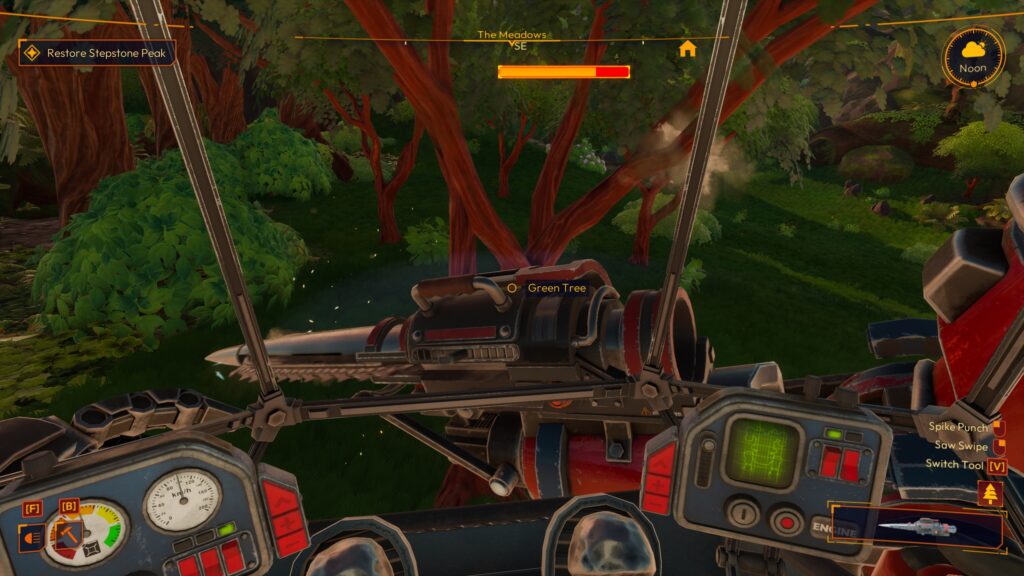
This is not a complicated game. You have two main tasks, the first of which is to collect materials. As with other “box” games, these materials are used to create machines and amenities that allow you to create other machines and amenities. Some of the first items you make are a tent to sleep in and advance to the next day, storage containers, and some planter boxes which you can use to grow specific plants you’ll need later on. As you stomp around the landscape collecting trees, rocks, and minerals, you will unlock new blueprints for crafting machines, better housing, and decorative items that, when placed within the confines of your sphere of influence (centered around your home), confer benefits to activities within your homestead.
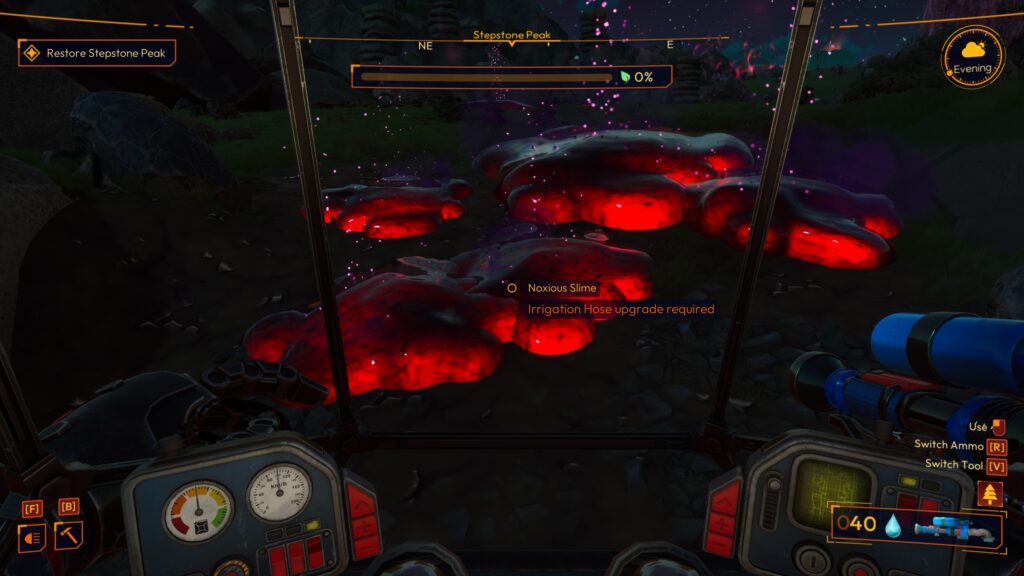
The second task is to clean up the various regions of the planet you’ve landed on. The game begins in “The Meadows”, a wide-open plain filled with basic materials such as trees, rocks, and aluminum deposits. There’s not a lot going on here, but nearby you’ll encounter Pine Heights, site of a mysterious and imposing wall of ruins. Your immediate goal in The Heights is to clean out a purple sludge called “noxious slime” with your irrigation cannon. Once you’ve cleared out “100%” of the slime (I actually got progress at 98%, but that’s good enough) you have “restored” the region. As you progress through your cleanup duties you find remnants of the original Lightyear homesteaders who apparently made great progress in settling the planet by building massive stone and high-tech structures, but who then vanished, their handiwork falling into ruin as the noxious slime took over. Cleaning up a region activates a chevron on a mysterious device which could be a door, or it could be a device which re-starts the Lightyear program. Who knows? It could be the signal needed to bring back the McRib for all I know.
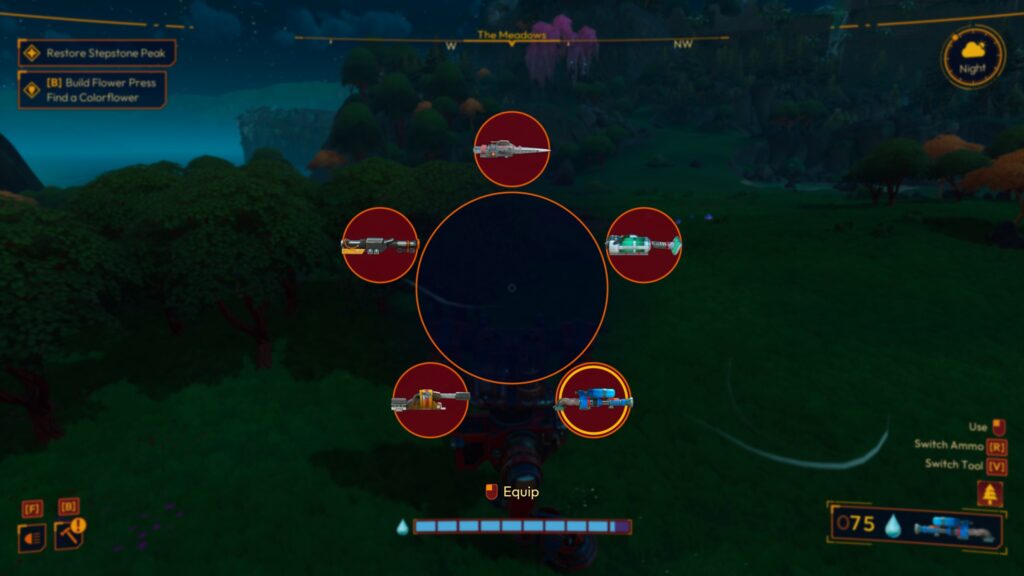
Idle Hands and All That
In this game, farming is both optional and essential. Seeds are collected using the vacuum attachment on the mech, and the seeds are used in the planter boxes to grow various alien fauna. Early on, the plants are only good for creating various oils that are needed for more complex construction jobs, but I don’t know if the need becomes more diversified later on. The mech also has a “sprout cannon” which allows for the firing of tree seeds into the bare ground to reforest areas after their predecessors gave their lives for the cute fence built around the property. Reforestation is a nice nod to the mission of sustainability and co-existence on this alien world, but it takes a few days to grow a tree and the seeds aren’t readily available, making it a conscientious task but not something that’s reliable as a usable resource. Planting seeds for oils is mandatory, though, and the number of planters and their composition is going to be dictated by a purely mechanical need for certain oils at certain stages.
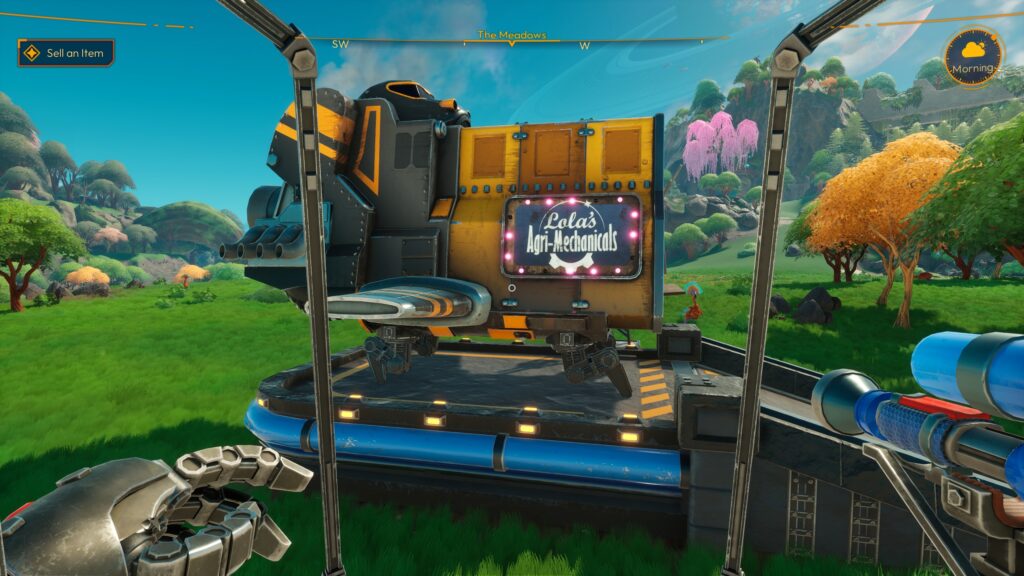
Early on, you’ll be tasked with building a landing pad, and after doing so you will be visited by a merchant each day — literally each day — who will buy items and sell you things in return. There are a mix of “needs” like raw materials of a stripe, and “nice to haves” like blueprints for benches, barrels, a cart, a bench, and monuments, each of which contributes to your homestead’s “coziness score”. I’ve sold many things but only bought a few, and the inventory doesn’t seem to change at all so I’m not entirely sold on this mechanic early on except to build a nest egg by selling a bunch of easily obtainable junk that has no purpose in the early game.
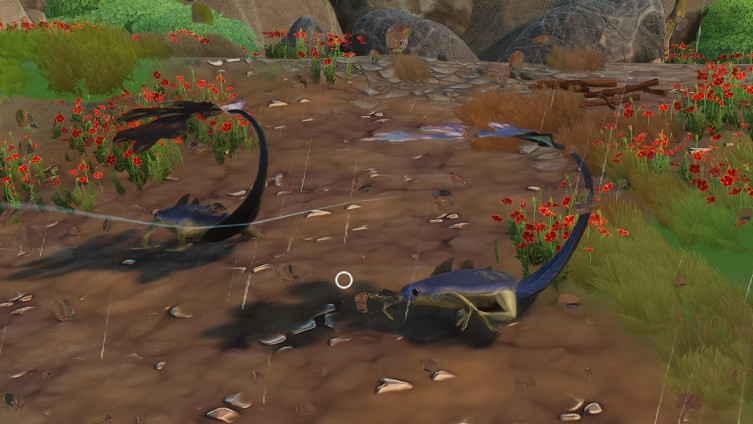
There are also native creatures to enjoy. Each region seems to introduce a new type, and while you can’t hunt these critters, you can produce treats for them. Providing a treat that the creature enjoys will cause them to “poop out” some kind of resource. In The Meadows, the dodo-like birds that strut around will provide basic materials like rocks, fiber, and even aluminum rods for some weird reason, and I am hoping that more advanced feed items given to more advanced creatures will provide more advanced materials, because I can find basic items pretty much everywhere for free. There seems to be some kind of achievement for feeding critters from distinct “nests” within a Region, but I haven’t gotten around to completing even one of those to figure out what the deal is.
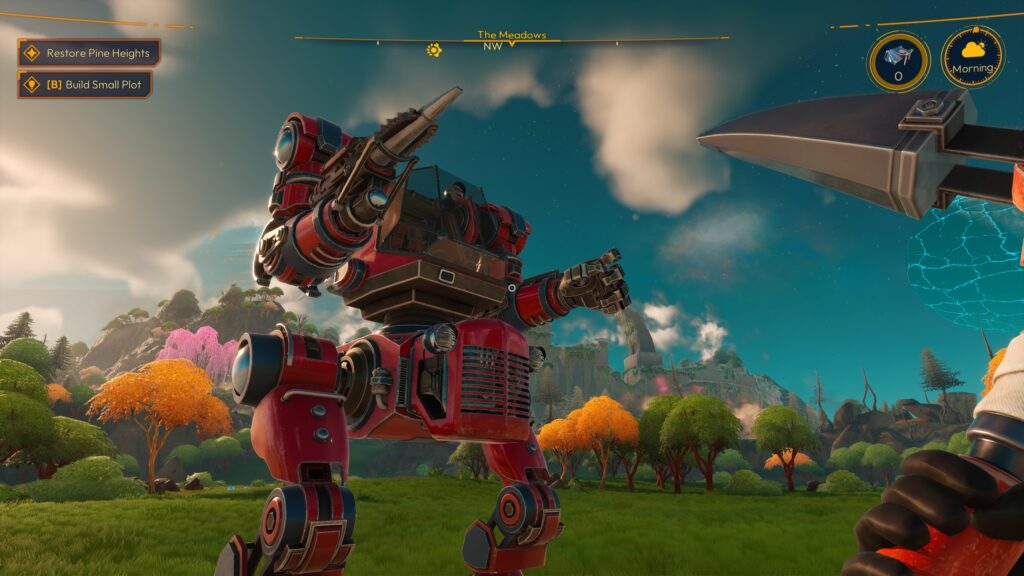
While most of the game is played from the cockpit of the mech, we can exit the machine and run around on foot. In this mode, we have a basic pickaxe-slash-tractor beam, and what I believe to be a small personal seed gun (I had no ammo for it and it doesn’t give it a name, so I don’t really know what it is). You can use the axe to hammer rocks and minerals, but you can only use the tractor beam to pick up items and return them to your mech where they are stored. There are several locations where you must dismount, like caves or more claustrophobic and overgrown areas, and exploring these places is often rewarded with an extra material node or collectable items, so keep an eye out!
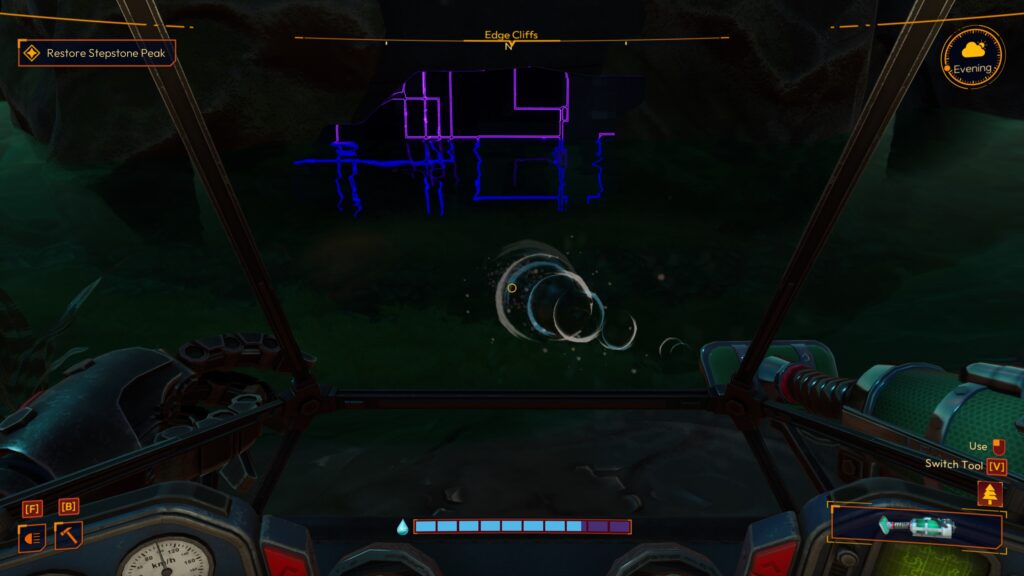
Overall, Lightyear Frontier is a calm, but sometimes frustrating, game of minor, non-urgent tasks with no clearly defined end-game goal aside from “clean up the planet”. The visuals are fantastic, with the planet represented by bright colors of dense vegetation and rolling hills of green grass and — dare I invoke it — reminds me a lot of Wildstar in many ways. There are day and night cycles, of course, and the late afternoon and early morning views as the local star sets and rises beyond the horizon are beautiful. Driving the mech is pleasant, with normal walking mode being sufficient to get between nearby POI, and the sprinting mode lends a sense of how ponderous your mechanical steed really is, with rougher course-correction handling. Each mech tool has a use, and early on you’re tasked with building a “mech bay” that provides a building-tree for upgrades to things like the water cannon tank capacity, mech inventory expansion, the power of your main cutting/mining tool, and more. Some resource gathering requires these advanced tools, so it’s important to work on upgrading the mech whenever possible. Although it won’t make much sense to 98.7% of the people reading this, I get a very distinct and similar vibe to two adorable VR games, Raccoon Lagoon and Garden of the Sea, which are similarly relaxing games which feature building, cultivating, and animal care opportunities. In that regard, Lightyear Frontier is even cozier than what the general Community currently calls “cozy”.
The downsides to the game are itchy, but not terribly game-breaking; in fact, I haven’t personally run into anything I’d call a “bug”. First and possibly a deal-breaker for some but not many/most/all players, there is no combat. The only “enemies” that the game provides are occasion events that might threaten your planting boxes in the form of descending noxious spores or floating blobs of slime that could infect your homestead and set your growing progress back by a few days. These events are easily countered by using your mech’s water cannon or vacuum attachment and have a very definite ending complete with on-screen acknowledgement that the event is over. Aside from that, none of the critters are killable, not even accidentally if you stomp on them with the mech. This is not a “survivalbox” game since there’s no surviving being done; at most, you sleep to allow the game to progress in proscribed ways but other than that you could keep going without any meaningful interruption.
Second, the inventory system is pretty Draconian. Rather than limit container capacity by number of items like many other games, each container has a weight limit, and it’s pretty low, especially when we’re talking about heavy-per-item stacks of things like rocks and wood. This system of relying on weight rather than slots means that inventory is strewn about wherever there is space and makes organization very difficult. With the capacity being as low as it is, it’s probable that a player would have several containers that hold nothing but heavy items, and a few contains with overflow of lighter-weight items. The good news is that once items are in containers within the influence of the homestead, crafting devices pull directly from those containers so we don’t need to search for items and bring them to the crafting table to get things done. The bad news is that the mech storage is similarly weight limited, and if you exceed that limit (whether you have upgraded the capacity or not), you get a mobility warning if you try to sprint or use jump-jets.
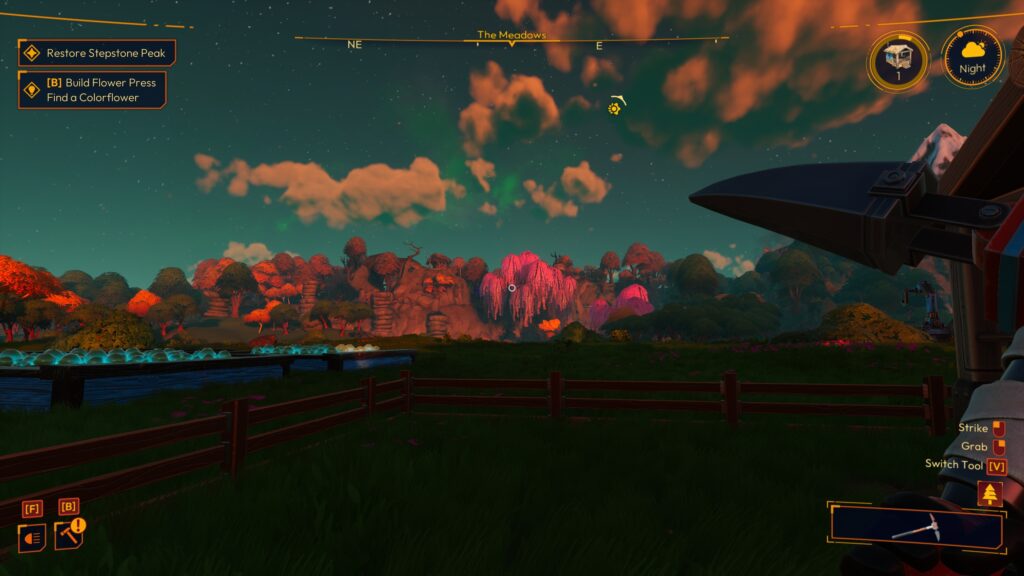
Third, the demo that I had played back during the last Next Fest was pretty good about guiding you through some initial building steps so you can get a handle on the flow of how to build and how the homestead system works. Either I short-circuited the released game by tackling tasks I knew had to be done (like building a tool shed to house the machines) or the game’s current state has somehow gotten rid of that initial hand-holding, but now there are very few prompts on what to do next. Making matters worse, I have recipes for things to build which require resources that I don’t have, but which I could apparently make, yet there’s nothing that tells me what I need to make those parts. New recipes are unlocked when new-to-us materials are harvested, which is not a new mechanic, but considering we have to push into a new region to start unlocking new materials, and how some new materials only show up once a region has been 100% cleared, it’s kind of a bummer to know what you need, but not where to get it, or when you’ll get it.
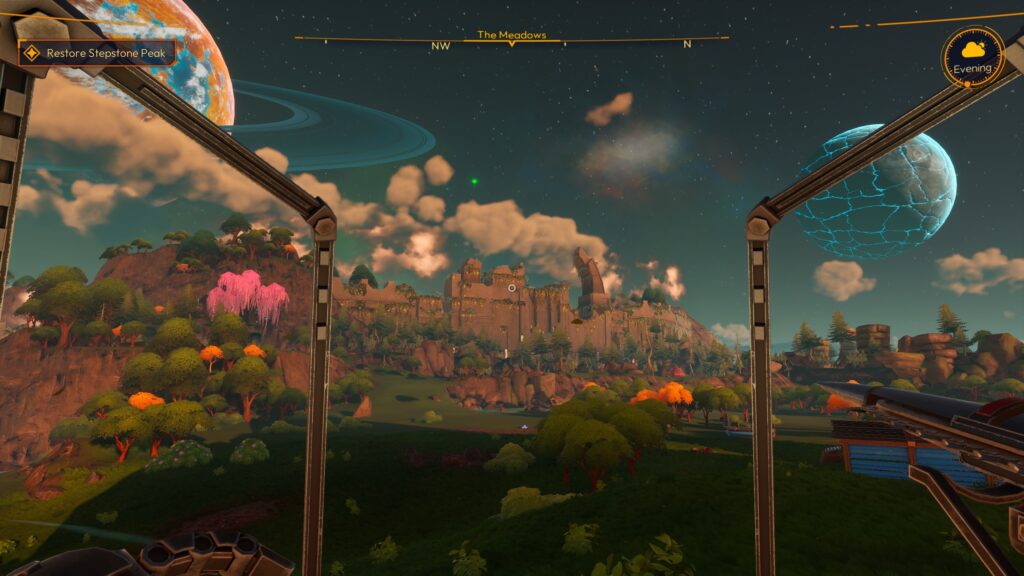
At the end of the day, though, Lightyear Frontier is relaxing. The music is calm (another trait shared with Raccoon Lagoon and Garden of the Sea) and you have a helpful NPC AI who fills you in on the planet history and drops voice lines every once in awhile. This NPC called PIP-3R, is an ancient monitoring satellite who was abandoned when the Lightyear program was shut down, so naturally she’s happy to see you. As an added bonus, you can always see her in the sky, represented by a green dot that pulses when she speaks, kind of like “God and the angels” from the beginning of It’s a Wonderful Life. And Lightyear Frontier kind of is, being a non-traditional cozy farming sim for people who are tired of the Same Old formula, and/or really like stompy mechs.





1 Comment
Nimgimli
March 21, 2024 - 8:47 amThis one is on Game Pass, for those of your readers who are interested. I’m looking forward to spending some time with it, as I too enjoyed the demo during the last Steam Demo Event.